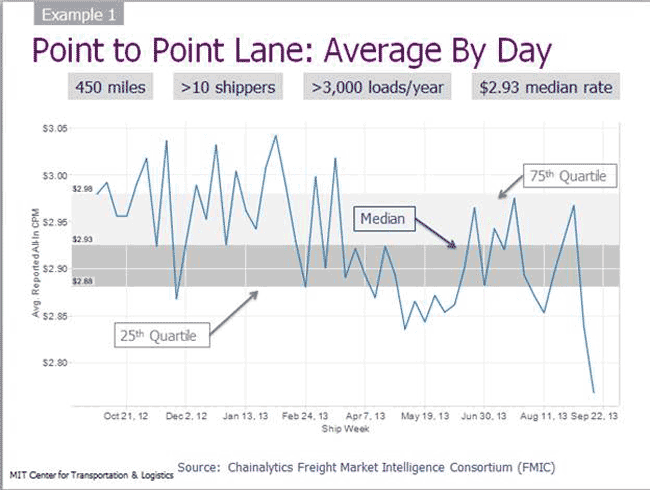From SCDigest's On-Target E-Magazine
- Jan, 5, 2015 -
Supply Chain News: The Myth of the "Market Rate" for Transportation Lanes
Dr. Chris Caplice of MIT Says that Unfortunately, it Really Does Not Exist
SCDigest Editorial Staff
Many companies spend a lot of time and in some cases invest some money trying to determine the "market rate" for a given transportation lane.
Why? As a benchmark against which they can measure their own contracted rates of course, with the implied ability to better negotiate with carriers based on this information. Several rate benchmarking services are out there in the marketplace that offer such capabilities, at least in theory. But is the concept of a "market rate" really mostly a myth?
SCDigest Says: |
 |
| As can be seen, what shippers are paying on average varies considerably throughout the year, leading to the obvious question of how a shipper would calculate the market rate based on this data.. |
|
What Do You Say?
|
|
|
|
Largely so says Dr. Chris Caplice, executive director of the Center for Transportation and Logistics at MIT and well-known logistics area expert.
Caplice made his comments as the keynote presenter at SCDigest's recent Transportunities 2014 on-line conference and exhibit.
Being able to discern the true "market rate" would certainly be useful, Caplice noted, saying such data could be used in budgeting, planning, logistics network design and more. One question around this subject is whether companies are looking for the average rate, or the best rate shippers are paying for a given lane. Caplice said that there is a little vagueness on this point, but most companies would be happy to just understand the average rate even though they would probably like to know the best rate, giving them a target to shoot for.
But the end, that question really turns out to be a moot point, Caplice believe, for several reasons. First, the data is simply hard to get. MIT recently worked on a study in which it looked at shipment data from over 100 companies. There was a surprising lack of commonality of lanes in the data set.
For example, only 3% of the total lanes overlapped between more than two firms, when looked at from a five-digit zip code perspective. Even when expanded to a three-digit zip range, only 25% of the lanes could be compared across more than two shippers.
"Most companies simply have very different networks," Caplice said, making benchmarking much more difficult than it might seem would be possible.
Confidentiality is also an issue, Caplice noted. Many carrier contracts state that the rates a shipper is paying cannot be directly shared say with another shipper, though providing data to the anonymous benchmarking services usually is allowed.
But in the end, trumping all of that, "We don't believe there is such a thing as a market rate," Caplice stated.
He and his colleagues come to that conclusion from looking at the data, which includes the information in the graphic below, based in this case on input from 10 shippers combining to move some 3000 loads per year in a specific 450-mile lane.

As can be seen, what shippers are paying on average varies considerably throughout the year, leading to the obvious question of how a shipper would calculate the market rate based on this data. Is it the average across some given period, such as a year? Is it the lowest rate paid over that period? There are no clear answers to these questions.
(Transportation Management Article Continued Below)
|